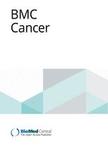版权所有:内蒙古大学图书馆 技术提供:维普资讯• 智图
内蒙古自治区呼和浩特市赛罕区大学西街235号 邮编: 010021

作者机构:Jinan Univ Affiliated Hosp 1 Dept Thorac Surg Guangzhou Peoples R China Jinan Univ Affiliated Hosp 1 Res Ctr Canc Diag & Therapy Dept Oncol Guangzhou Peoples R China First Peoples Hosp Foshan City Dept Radiat Oncol Foshan Peoples R China First Peoples Hosp Zhaoqing Dept Breast Oncol Zhaoqing Peoples R China Sun Yat Sen Univ Affiliated Hosp 7 Dept Geriatr Shenzhen Peoples R China Hosp Southern Univ Sci & Technol Dept Clin Nutr Shenzhen Peoples R China Jinan Univ Zhuhai Peoples Hosp Zhuhai Inst Translat Med Guangdong Prov Key Lab Tumor Intervent Diag & Trea Zhuhai Peoples R China Jinan Univ Biomed Translat Res Inst Fac Med Sci Guangzhou Peoples R China
出 版 物:《BMC CANCER》 (BMC Cancer)
年 卷 期:2025年第25卷第1期
页 面:1-11页
核心收录:
学科分类:1002[医学-临床医学] 100214[医学-肿瘤学] 10[医学]
基 金:Shenzhen Science and Technology Program
主 题:gamma delta T cell Immune exhaustion NSCLC Chemotherapy Targeted therapy
摘 要:BackgroundMultiple studies have demonstrated that the abundance and functionality of gamma delta T cells are favorable prognostic indicators for prolonged survival in cancer patients. However, the association between the immunophenotype of circulating gamma delta T cells and the therapeutic response in NSCLC patients undergoing chemotherapy or targeted therapy remains *** with EGFR wild-type (EGFR-WT) or mutant (EGFR-Mut) non-small cell lung cancer (NSCLC), diagnosed between January 2020 and January 2024, were included in this study. Clinicopathological characteristics, treatment regimens, and follow-up data were retrospectively collected. Peripheral blood samples from 52 NSCLC patients were analyzed for the immunophenotypes of alpha beta T cells and gamma delta T cells using full-spectrum flow *** significant differences were observed in the proportions of alpha beta T cells or gamma delta T cells, nor in the expression of immune exhaustion markers, between epidermal growth factor receptor wild-type and mutant NSCLC patients. Notably, NSCLC patients with a high clinical benefit rate (responder, R) exhibited a higher proportion of circulating V delta 2 T cells compared to non-responders (NR), in both EGFR-Mut (NR vs. R, P = 0.0437) and EGFR-WT groups (NR vs. R, P = 0.0180). Additionally, the expression of the immune exhaustion marker PD-1 on V delta 2 T cells was significantly lower in the responder group (NR vs. R, EGFR-Mut, P = 0.0050;EGFR-WT, P = 0.0180). Moreover, responder patients exhibited elevated levels of TNF-alpha compared to non-responders, irrespective of EGFR mutation status (NR vs. R, EGFR-Mut, P = 0.0055;EGFR-WT, P = 0.0007).ConclusionsThese findings collectively suggest that circulating V delta 2 T cells with low levels of immune exhaustion are critical contributors to the effectiveness of chemotherapy and targeted therapies in NSCLC. Targeting V delta 2 T cells may represent a promising strategy for enhancing the